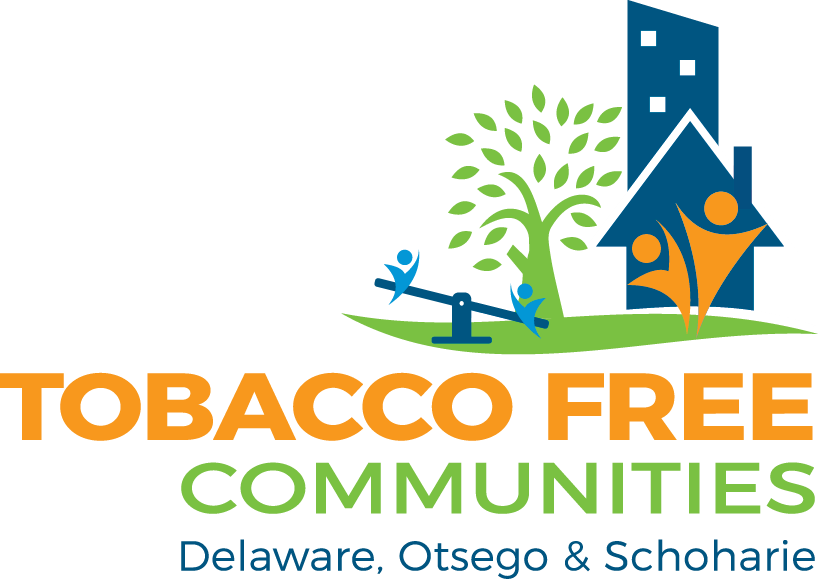Tobacco Control Reps do a Reality Check with State Lawmakers
Representatives from Advancing Tobacco Free Communities in Delaware, Otsego and Schoharie Counties (ATFC-DOS) met with NYS Senator James Seward and NYS Assemblyman Clifford Crouch while in Albany for the annual NYS Tobacco Control Partners Legislative Education Day. Linda Wegner, Program Director for ATFC-DOS and Deyanira Cisneros, Community Engagement Coordinator for ATFC-DOS accompanied six Reality Check youth advocates from Cherry Valley-Springfield Central School to Albany. Tranquility Cleveland, Jillian Johnson, Jasmine Neill, Ahna Misiewicz, Ali Misiewicz and Arianna Mosenson helped educate lawmakers about tobacco use issues in local communities. They also shared their concern about the average age of a new smoker being 13 and the smoking rates in the Delaware, Otsego and Schoharie region being higher than the current statewide adult smoking rate of 14.2 percent – 22.9 percent for Delaware County, 26.3 percent for Otsego County and 19.3 percent for Schoharie County.
The NYS Tobacco Control Program is a network of statewide contractors who work on Advancing Tobacco-Free Communities, which includes Community Engagement and Reality Check, the Health Systems for a Tobacco-Free New York, the NYS Smokers’ Quitline and Surveillance and Research. NYS Tobacco Control Partners have contributed substantially to the drop in tobacco use rates among adults and youth through population-based, policy-driven and cost effective approaches to prevent youth from smoking and to help smokers to quit. These approaches are now focusing on communities and populations with high tobacco use rates, especially those with poor mental health, low education and low income.
“We need to ensure that all New Yorkers regardless of income, education, race or mental health status, are given the help they need to quit tobacco use and, more importantly, to live in environments that makes it less likely they will become addicted to the single leading cause of preventable death and disease in our state,” said Amanda Mulhern, Health Systems Coordinator with St. Peter’s Health Partners Community Health Programs who serves Delaware, Otsego and Schoharie Counties among a total of eight counties.
Another population that warrants attention is youth. While youth smoking rates have significantly declined, electronic cigarette use among the state’s middle and high school students has doubled from 2014-2016[i], and studies show e-cigarettes can be a precursor to cigarette smoking in youth, even those who were not likely to smoke cigarettes.[ii]
“State-funded tobacco control programs prevent youth tobacco use and reduce adult smoking rates and ultimately save lives and millions of state tax dollars,” said Deyanira Cisneros, Community Engagement Coordinator with ATFC-DOS. “But, as data about New Yorkers with low income, low education, mental illness and youth tobacco use show, when it comes to deadly and addictive tobacco use, the fight to save their lives isn’t over.”
The Centers for Disease Control (CDC) recommends that the Tobacco Control Programs in NYS be funded with $203 million, yet actual funding for these programs only totals $39 million.[iii] If these programs were adequately funded, the health and economic burdens of tobacco use could be significantly reduced.
Annual health care costs directly caused by smoking in New York State are $10.39 billion. This expense results in a tax burden of $1488 dollars for each New York State household every year.[iv] There are 28,200 deaths in New York State each year due to smoking, and thousands who are living with illnesses related to tobacco use.iii
For more information, visit TobaccoFreeNY.org and NYSmokeFree.com.
###
i NYS Dept. of Health, Bureau of Tobacco Control StatShot Vol. 10, No. 1/Mar 2017, accessed 1/2/18, https://www.health.ny.gov/prevention/tobacco_control/reports/statshots/volume10/n1_youth_cigarette_and_ends_use.pdf
ii Journal of Tobacco Control, Feb. 6, 2017, accessed 1/2/18, http://tobaccocontrol.bmj.com/content/early/2017/01/04/tobaccocontrol-2016-053291
iii Campaign for Tobacco Free Kids, Key State-specific Tobacco-Related Data & Rankings, FY18, accessed 1/2/18, https://www.tobaccofreekids.org/assets/factsheets/0176.pdf







